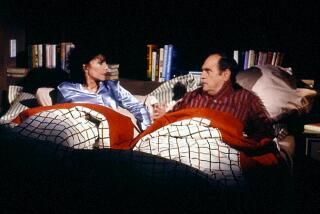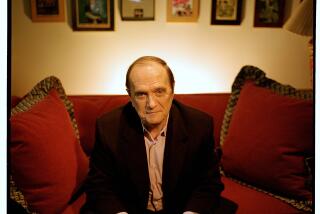PROFILE: Ruth Waldo Newhall : Conscience of a Community : The journalist, author and recent widow of a local legend reflects on the past but looks always to the future.
- Share via
In her 82 years, Ruth Waldo Newhall has lived a roller-coaster life--swerving with the changing times and often soaring ahead of them.
She has worn a variety of hats--anti-Vietnam War activist, feminist before the term came into vogue, college instructor, community mover and shaker, journalist and author of several books. Her latest book is “A California Legend,” a history of the Newhall Land & Farming Co. and the hamlet-to-suburbia Santa Clarita Valley that she and her late husband, flamboyant newspaperman Scott Newhall, helped give texture and shape.
To accomplish all of this and more, she has wielded what a friend calls “a velvet sledgehammer” for so long that those who know her find it hard to think of the “Matriarch of the Santa Clarita Valley” as retired and widowed.
Her blood still oozes the printer’s ink that she and Scott Newhall unleashed in the Newhall Signal for 25 years, sniping at sacred cows, stiff-arming developers they felt did slipshod work and striving to fulfill what a former co-worker calls “Scott’s dream of creating a Shangri-La out of this dusty little outpost.”
“I’m old now--and I mean really old,” Ruth Newhall said recently. “It’s so incredible to me now because I don’t feel any different than I did.”
She sits in the sunlit front room of “the Mansion,” or what some call the “Poor Man’s Hearst Castle,” the rebuilt, three-story Victorian house where she now lives with Tori, the family Great Dane, in the Ventura County community of Piru, 20 miles west of Newhall.
She talks of life’s joys--travels overseas, rearing four children, trips with her five grandchildren and putting out newspapers, all in partnership with “Scotty,” her husband for nearly 60 years before he died at 78 last October of acute pancreatitis.
Scott Newhall left a legacy as a free-spirited, crusading editor who energized the San Francisco Chronicle (1952-71), the Signal (1963-88) and finally the Santa Clarita Valley Citizen (1988-89) with flashes and dashes of H.L. Mencken and P.T. Barnum.
“I’m so busy right now, trying to sell off so many of Scotty’s things that I don’t really need,” she says between trips to San Francisco, where the Newhalls have long owned an apartment that stores her husband’s papers. “It’s going to take me a year to get it all straightened out.”
She also chooses not to dwell on previous sorrows--the death of her only daughter, at 12, hit by a truck; the amputation of Scott’s left leg, severely infected after he had been kicked by a horse; the accidental fire that burned the mansion to the ground in 1981.
More recently, she mourned the collapse of the Santa Clarita Valley Citizen, the renegade twice-weekly that Ruth and Scott started in 1988 from scratch inside a cramped, double-wide trailer, the staffers (including the Newhalls) even briefly binding copies in rubber bands and hand-throwing them.
The Newhalls, then in their late 70s, had quit the Signal in a dispute with the paper’s corporate ownership--and about 25 Signal employees followed them to the Citizen--but their scrappy publication ran out of money and died in May, 1989, after only eight months.
“That’s life--you don’t stop and brood about it,” Ruth says. “I mean, you count your blessings. I’ve had lots of them. Anybody who’s alive has blessings to count.
“Of course, the one thing you don’t want to go downhill is your mind or your health. That is where I feel Scotty was so fortunate. We talked about that--the spectre of being bedridden or having Alzheimer’s or one of those horrible things. So if you can escape this life without running into one of those things, then you’ve been lucky.”
Ruth Newhall edited the Signal and wrote a popular column called “Gossip By Mimi,” while son Tony ran the business and Scott ignited the paper’s soul with pull-no-punches editorials that readers either devoured or detested.
Even as Ruth talks about her own life, she invariably speaks of “Scotty,” with whom she traveled often to Mexico, collected antiques, restored vintage cars and rebuilt the mansion, where they hosted company picnics and black-tie dinners.
“Scotty and I had a great time together--I have absolutely no regrets--but we had some bad times, too,” she says, referring to her husband’s heavy drinking early in their marriage in San Francisco.
“I just told him I wasn’t going to be married to a drunk, and I was going to leave. And that was that. He saw a psychiatrist and had to live at the YMCA, apart from me, for about six months. It worked out fine. For the last 30 or 40 years, he never touched a drink. Ever.”
Those who know Ruth Newhall best--family, friends, former co-workers and developers savaged by Scott’s editorials--scoff at the notion that their mom-and-pop newspapers and community activism packed more pop than mom.
“She was on an equal plane with him all the time,” says Jo Anne Darcy, a Santa Clarita city councilwoman and former mayor. “When Scott would fly into a rage over certain things, Ruth was always the one who carried the sponge behind him and kept the impact to a minimum.”
Onetime Signal and Citizen reporter Emory Holmes says the Newhalls reminded him of “a constant storm. Scott was the thunder and lightning. Ruth was the rain and lightning. She was just as lethal as Scott in her assessments, except that she pondered them longer. I thought I was working with Mark Twain and Katharine Hepburn. They elevated your sensibilities.”
Some recall that after Scott pounded out his editorials on an old Royal typewriter, grittily refusing to be dragged into the computer age, Ruth sat at a video display terminal, editing his copy that someone had typed into the system.
“You can’t say it this way!” someone quoted Ruth as shouting at Scott.
“I’m saying it the way I want to!” Scott shot back. “If you don’t like it, I’m going home!”
Ruth stayed long into the night, polishing Scott’s turgid prose that often had readers scrambling for the dictionary, adversaries running for cover and purists shaking their heads:
“News of a catastrophic nature arrived early Monday morning when Miss January Jones, the nouvelle and languorous Society Editor, complained that numerous local ladies were fighting a losing battle against the Rococo prose of this newspaper’s editorial messages.
“This is absurd. Signal editorials are written in clear, concise, Dick-and-Jane basic English. They are models of grammatical good taste and the quintessence of semantic check. Therefore, what in the hell is all this Monday morning moaning about? . . . “
Together, Ruth and Scott Newhall refined the rare skill of attacking foes in print--and then inviting many of those very foes to parties at the mansion.
“I don’t make my friends by their opinions,” Ruth says. “When I’m with people with whom my beliefs are at odds, we just don’t discuss those things. We talk about other things--like the orange crop.” She laughed.
A former Signal reporter who says he was fired by the Newhalls and who chose to talk anonymously says he doesn’t recall the “velvet” in Ruth Newhall’s so-called “velvet sledgehammer.”
“Ruth ran the place,” he adds. “She was always on the scene--Scott was hardly ever there. She was one tough woman.”
Santa Clarita Valley home builder Jack Shine, who clashed often with the Newhalls, described them as “very independent thinkers.”
“I looked at them as a unit,” said Shine, chairman of Encino-based First Financial American Beauty Homes. “Over the long haul, you never really knew which one was doing what to you.”
Ruth Newhall was born Ruth Waldo on July 3, 1910, in Berkeley, the eldest of three children of middle-class parents who, she said, “weren’t great intellectuals, but they wanted me to be one. My mother, I think, wanted me to be President.”
As a graduate teaching assistant in art at UC Berkeley (where she had been student body president), Ruth met and fell in love with an undergraduate art major, Scott Newhall, scion of Southern California’s pioneer Newhalls, his immediate family devastated by the Depression.
To her parents’ dismay, Ruth and Scott eloped to Reno in 1933, Scott’s mother tagging along to grant the underage groom--Scott was 19--permission to marry.
In 1934, Scott took a photographer’s job at the San Francisco Chronicle, rising to editor of the paper’s Sunday magazine and, in 1952, to executive editor. Ruth, too, joined the Chronicle, serving as editorial secretary, assisting a new columnist named Herb Caen and writing Sunday magazine articles and book reviews.
She also took time off to bear children: Skip, now 54 and a mathematician for the Jet Propulsion Laboratory in Pasadena; twins (now 51) Tony, now assistant to the publisher of the San Francisco Chronicle, and Jon, an Atlantic Bell executive in San Rafael, and Penny, who, at 12, died when a runaway driverless truck hit her while she and others were Christmas caroling.
In 1963, Scott and Ruth Newhall purchased the Signal with money from a bank loan--even as Scott continued to help rejuvenate the Chronicle. When the newspaper editorialized against the Vietnam War, Ruth joined protest marchers in the streets.
In Newhall, Scott also sat on the Newhall Land & Farming Co. board, remaining inactive while at the Signal. But when the Signal ran a story that Newhall Land’s then-chairman, Atholl McBean, didn’t like, McBean “was furious--he got the bank to cancel the Signal’s loan guarantee,” Ruth said.
The Newhalls sold the paper in 1978 to Morris Communications of Savannah, Ga., staying on to help it keep turning a profit.
The paper watchdogged the Santa Clarita Valley’s rapid growth, championed cityhood for Santa Clarita in 1987 and attacked what the Newhalls called shoddy development.
Even Newhall Land, the area’s largest developer, wasn’t spared the Signal’s wrath, although a dispute rages to this day over whether the newspaper treated the company too kindly.
“The Newhalls were very idealistic about how their paper should be run,” Thomas L. Lee, Newhall Land’s chairman and chief executive officer, recalled. “When the Newhalls felt we did something wrong, they never hesitated to let everybody know.”
City Councilwoman Jo Anne Darcy described the Newhalls as “not anti-development but for quality development. They fought with a lot of developers--many with good reason. They didn’t want trash in this valley.”
Today, many of Ruth and Scott Newhall’s ex-colleagues remain unshakably faithful to the Newhalls’ style of journalism.
“They always thought a newspaper should entertain,” said Linda Pedersen, who wrote a Signal society column under the pen name “Carolina Kelly.” “And they knew that if you put people’s names in the paper, they’ll want to get more involved in their community.”
When the Citizen folded in 1989, the Newhalls remained unbowed.
A front-page editorial by Scott concluded: “Newspapering is a pleasure and a privilege. Newspapering is the best and the brightest world of all.”
Now, Ruth Newhall ponders selling the mansion as she sorts out her husband’s estate and her own tomorrows.
“It doesn’t make any sense for one old lady to live in a great big house like this,” she said. “But then, we’re not going to find a buyer for this place the moment it goes on the market. People who want to pay the kind of money that I’m going to want for this place usually prefer to live in Beverly Hills.”
She reminisced again about Scotty and their decades together. “My son Jon said about the nicest of all things,” she said. “He told me, ‘Dad never got old.’ ” “Has anyone ever said that about you?” she was asked. She blinked and said: “Well, I’m not dead yet!”
More to Read
Sign up for our Book Club newsletter
Get the latest news, events and more from the Los Angeles Times Book Club, and help us get L.A. reading and talking.
You may occasionally receive promotional content from the Los Angeles Times.










